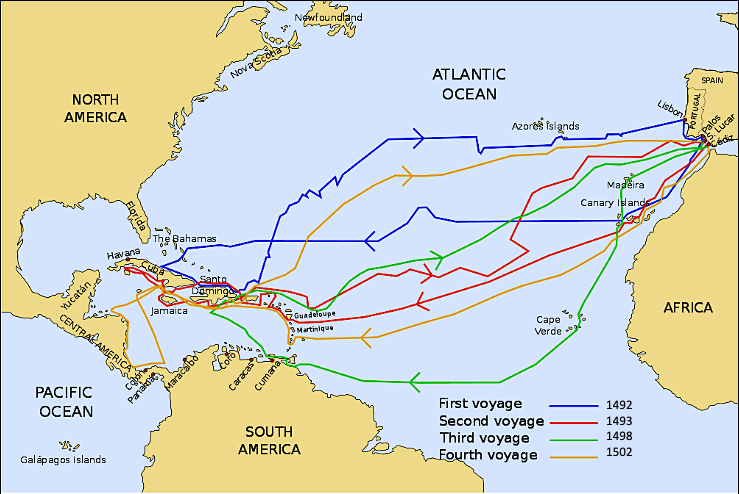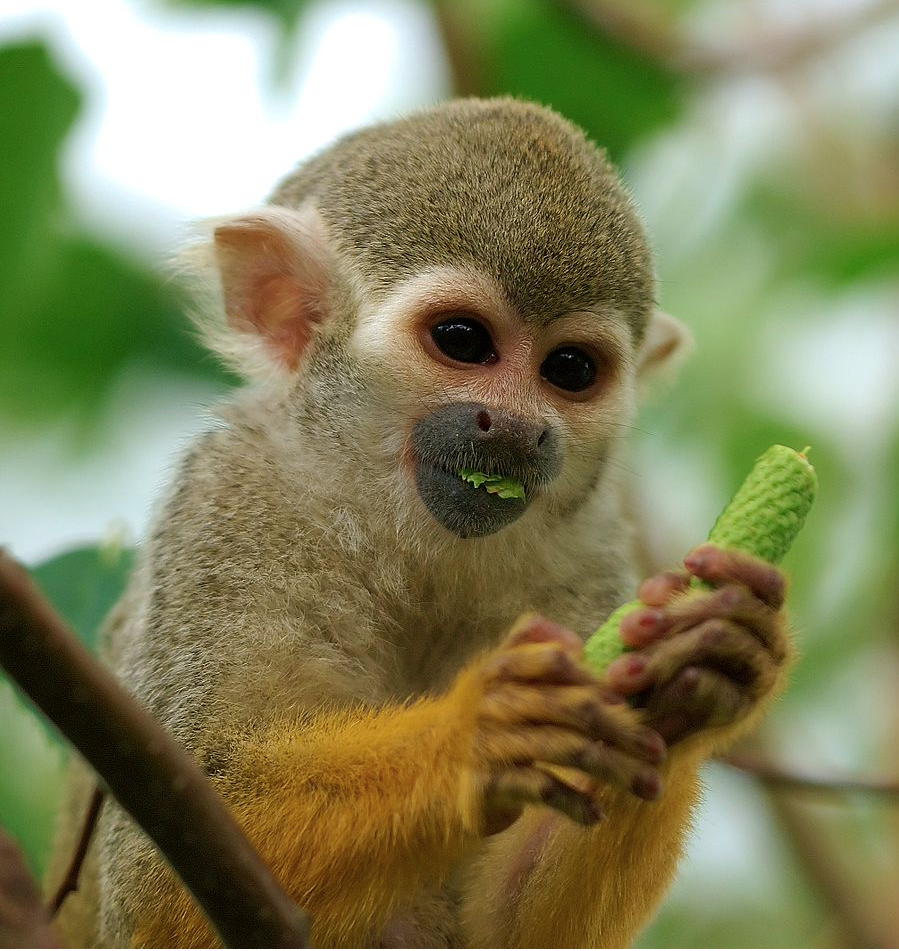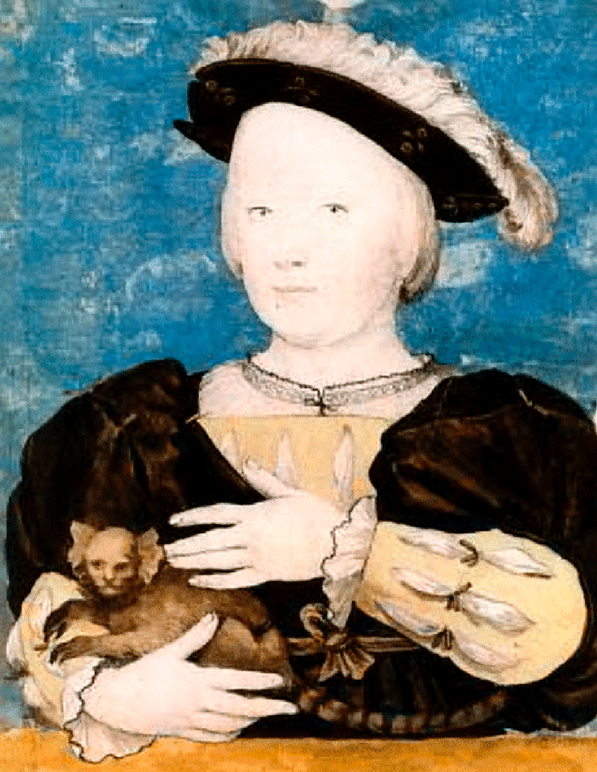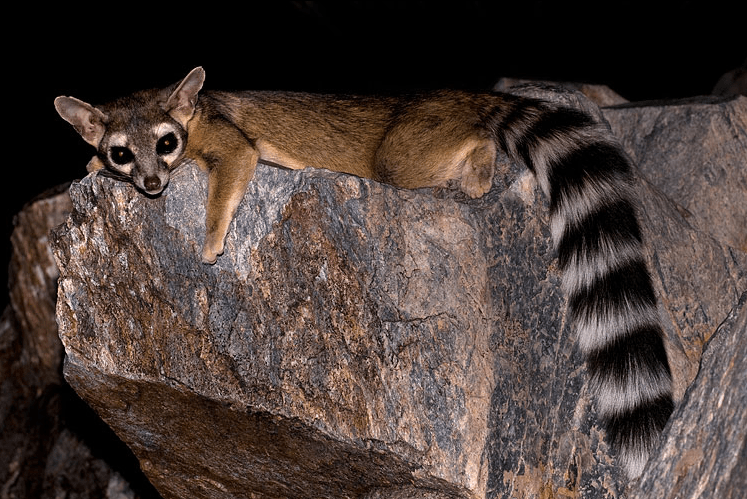In 1492 Christopher Columbus (1451 – 1506) sailed under the Spanish flag and discovered a whole new land. Six years later the Portuguese explorer, Vasco de Gama (1460 – 1524) reached India’s Malabar coast, which had been a centre of trade between Arab and far eastern merchants for at least fifteen hundred years. Columbus’s voyage west led to the discovery of a totally new continent where he found similar fauna to species found in Europe.

This miniature of Katharine of Aragon with her pet monkey dates from the mid 1520s, painted by Lucas Horenbout (d1544).

The simian may be a Panamanian white-faced Capuchin monkey, which is wide spread through Central and South America. They grow to about 22 inches tall, plus their tail.

Highly intelligent creatures, the Capuchin monkey was for years the simian companion of the 18th century Italian organ grinders. A female capuchin monkey called Chiquita has appeared in the Pirates of the Caribbean series as Jack the Monkey.
In Christian iconography monkeys represent the negative human traits of lust, greed, avarice and ambition; in Mexico they are symbols of lust.
Alternatively, the pet may be a squirrel monkey of which there are five species and is endangered in the wild. These monkeys are considerably smaller than the white faced capuchin and judging from the size of the animal in the miniature, the moneky is very possibly one of the many species of capuchin.

The Horenbout miniature of Katharon of Aragon was painted at about the time Henry VIII’s eyes had alighted on Anne Boleyn, so this may be the monkey that Anne is said to have disliked so much. A closer look shows the monkey wears a belt around its waist and Queen Katharine is keeping it from wandering off by having it attached to a long chain, which limits its ability to cause chaos. One on hand, this portrait could be read as the queen showing off her pet that came from the Spanish territories. On the other, it could also be read as an allegorical message by those who were invited to view the miniature, that she recognised her lusty husband had a wandering eye, but he was forever attached to her by the chains of marriage.
Whether Anne Boleyn understood the message in this way we do not know, but this Horenbout miniature might explain her dislike of monkeys. On the other hand we know from various inventories and accounts that monkeys were sold in London. Dr Jenny Stratford has written about a London merchant called Robert Buckland who was tasked with supplying monkeys, parrots and salamanders to the court of Henry V, and monkeys are listed in various inventories. Clearly owning such an exotic animal was a status symbol.
A Holbein preparatory sketch has been given the title of ‘A young boy with his pet monkey’.

Basel. Source Wikipedia
Initially I thought this boy’s very quiet animal might be a marmoset or ring-tailed lemur, but international wild-life photographer Charles J Sharp suggested the docile animal more resembles a ring-tailed cat, a member of the racoon family and native to the southwestern US and Central America. This species of racoon make excellent pets and are apparently far more amenable than ring-tailed lemurs, marmosets or tamarinds who are very lively and cause chaos, just like other species of simian.

(Image source: Wikipedia)
Since this animal is indigenous to places explored and colonised by the Spanish, if it is accepted this is a ring-tailed cat then it, like Katharine of Aragon’s Capuchin monkey, it may have come to England via Spain, arriving in England prior to Henry VIII’s divorce. If this is the case, the Holbein sketch of this boy has to date to before 1528/9. This gives us a clue for determining the possible identity of the sitter as possibly being that of Henry Fitzroy (born in 1519), the illegitimate son of the English king. From his plump facial features this child is clearly pre-pubescent, which suggests Holbein possibly did this sketch during his first stay in England.
On the other hand, Franny Moyle has concluded that the sketch may have been copied or inspired from a miniature by Jean Clouet (1485-90? – 1540/1) of Francis Dauphin of France (1518 – 1536), the older of the two sons of Francis I held hostage by Charles V in exchange for their father who had been captured in the battle of Pavia in 1525. The two boys were not released until 1529 as part of the terms of the peace treaty negotiated by Louise de Savoie and Margaret of Hungary and signed on 3rd August of that year.

The Clouet miniature of Francois, Dauphin of France (1518 – 1536), now in the Royal Collection Trust (RCIN 420070), bears a remarkable similarity to the boy in this sketch, with the only major difference being that the child is posed looking to the right. The doublet and sleeves appear to be the same, even down to the fine linen undershirt with the blackwork embroidery around the neck, but we are unable to see the sleeves in Clouet’s portrait.
Moyle suggests that Holbein was taking his inspiration from Clouet’s miniature, but is it possible that IF, and it is a big IF, the animal is accepted as a ring-tailed cat/racoon from the New World, then perhaps the sketch in Basel was done from life? Any animal from the countries being explored by the Spanish, be it marmoset or ring-tailed cat, could have been given to the Dauphin as a pet while he was held hostage in Spain. Equally, perhaps the animal was sent to France as a gift in the mid 1520s, but it was unlikely to have come from Spain or indeed, England, since Spain and England were allied against France in the Italian Wars of 1521 – 1526.
The Clouet miniature is part of the Royal Collections Trust and came into the collection during the reign of Queen Victoria, but no previous provenance is given on the RCT website. It is suggested that the miniature was painted when Francis was aged six. Considering the age when boys were breeched was the age of seven, is it likely that the child would be dressed in what are obviously adult clothes? However, if the boy were eleven or even twelve years of age he would be dressed as in this portrait, plus his features would still have elements of the chubbiness of childhood.
Holbein visited the French court before he finally arrived on English shores in the mid 1520s and it would not challenge the bounds of possibility that the great man sketched the Dauphin with his favourite pet at that time. The Dauphin and Henry Fitzroy were born a year apart, just to add to the debate.
Another possibiity is that on his way home from England to Basel in 1529 Holbein sketched the Dauphin with his pet given to him while he was a hostage in Spain. He and his brother had been exchanged for their father, Francis I of France. If this were the case, then that would explain the presence of a New World ring tailed racoon.
§
This article stems from my research undertaken over the past 5 years into visual evidence of exotic fauna seen in illuminated manuscripts and documents from the 13th to 16th centuries. I presented a paper at the Harlaxton Medieval Zoomposium in July 2021 titled In Search of the Exotic and this is just one aspect of that evidence.
© MVT 2021.

13 thoughts on “Monkey business at 16th century royal courts”